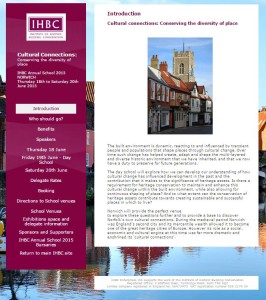There a has been a warm welcome from across the conservation and development sectors to the news that the UK’s key conservation link body, COTAC, is to recast itself as a Charitable Incorporated Organisation (CIO) under the new title of the ‘Council on Training in Architectural Conservation’ – still to be known as COTAC.
Under the new arrangements, agreed at a recent general meeting, COTAC remains as a membership body supported by members that range from English Heritage to the National Churches Trust.
Of course COTAC continues to offer a warm welcome to new members seeking to support the organisation’s aims and objectives.
Supporting the new arrangements, Lady Tina Feilden, COTAC’s Patron and wife of the late conservation architect Sir Bernard Feilden, said: ‘It has been my great pleasure to have been a Patron of COTAC over the last 5 years, and to watch how it has developed and influenced many over that time.’
‘In the current period of considerable change, it is gratifying that a greater understanding of the need to retain, protect and sensitively utilise our stock of traditionally constructed buildings has continued to grow. Proudly, COTAC has frequently been at the forefront of related initiatives. Whether this is informing standard setting, developing knowledge, or enabling the connection of broken and new links across the built heritage sector, COTAC has excelled.’
‘The work of the regenerated ‘Council’ represents so closely the ideas and teaching of my late husband, Sir Bernard Feilden, that I know he would have readily endorsed its aims. I continue to happily support its work in his name and, as Patron, I wish it every success for the future’.
David Mitchell, Director of Conservation, Historic Scotland said: ‘COTAC has long been recognised by the National Heritage Agencies in the UK and beyond, and we have always enjoyed a close working partnership. I am pleased to see that COTAC has reflected on it’s role and is implementing changes to ensure it remains relevant and key to conservation and training into the future’
COTAC Chair, Ingval Maxwell, said: ‘The new operational structure of a CIO will allow COTAC to be more flexible and inclusive in its operations, and so able to shape and react to the rapidly changing work environment we, and our members, see today. At the same time we will be able to keep a eye on continuing the legacy of our many previous successes, from our standard setting developmental role in vocational training, to the hosting of the pre-eminent on-line learning tool for specialists seeking conservation accreditation – our understandingconservation.org website. Through our successful annual conference series we have, once again, also marked out our role in generating cutting edge conservation practice and debate’.
COTAC’s CIO pending initiatives include:
- Developing the understandingconservation.org site as an online tool that offers a recognised route to member accreditation
- Developing BIM4C (Building Information Modelling for Conservation) as a tool fit for purpose in historic building care, management and change
- Maintaining its annual conferences as the ‘go-to’ event for members of lead professional bodies to explore current and future building conservation trends and directions
- Developing a sustainable income stream through growing its membership and support network, and through key project developments
COTAC Membership
COTAC plans to include both organisation and individual membership, on three levels:
- Partner Members
- Ordinary Members
- Network Members
COTAC: Background and future
Established in 1959 as the ‘Conference on Training in Architectural Conservation’ COTAC’s founding principle was its recognition of the need for specialists to properly specify and oversee work involved in repairing and conserving historic buildings and churches. This ground breaking approach in the mid 20th century occurred when training in modernism, concrete and brutalism prevailed, and the knowledge of traditional building technologies was fast disappearing.
Over the years COTAC has always worked hard at lifting standards, developing training qualifications and building networks across the sector. This has involved national agencies, professional bodies, educational establishments and training interests. Today, COTAC can boast a unique legacy of success that was summarized in its 50th Anniversary publication ‘Half a Century On’.
COTAC’s 21st century role is no less critical. New technologies, including aspirations to low carbon retrofit, demanded energy efficiencies and emerging digital innovations, can too easily obscure the need for a core understanding of traditional materials and how to approach historic structures with a finely honed set of skills. In its new structure, as the ‘Council on Training in Architectural Conservation’, COTAC’s priority objectives include:
- Setting, maintaining and promoting standards for conservation education and training
- Developing, producing and promoting education and training materials
- Collaborating with other organisations, voluntary bodies and agencies with interests in conservation, with a view to influencing and promoting relevant issues
- Maintaining and developing the Council’s digital resources to ensure their relevance for the sector and the public
- Promoting courses at all levels in conservation of the historic environment which are relevant and in accordance with recognised criteria
- Publishing relevant material
- Arranging seminars, conferences and participating in exhibitions relating to relevant heritage issues
- Resources permitting, providing bursaries and other support for relevant studies and course attendance.
Note:
To download ‘Half a Century On’ see COTAC’s web-based resources at www.cotac.org.uk including www.understandingconservation.org
Any queries on membership may be directed via COTAC’s web page


